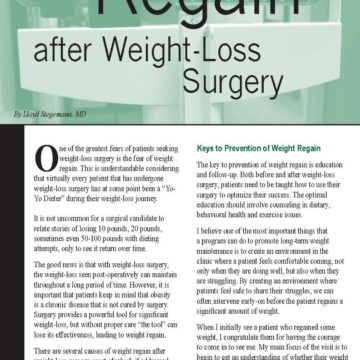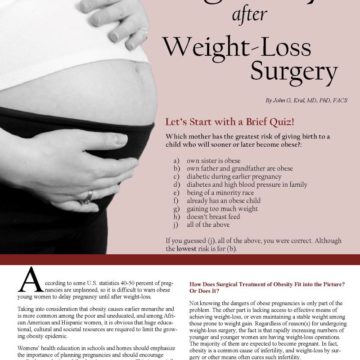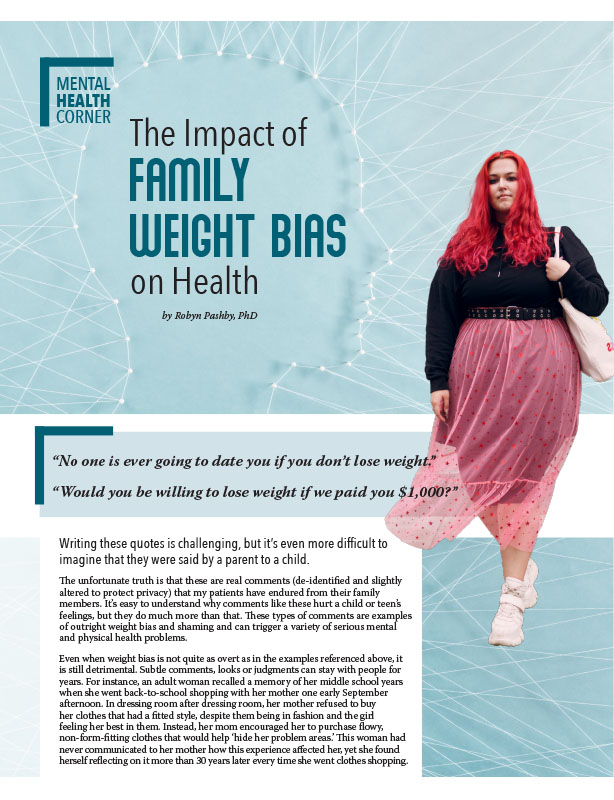LAP-BAND® FAQs: Questions Most Commonly Asked by Patients

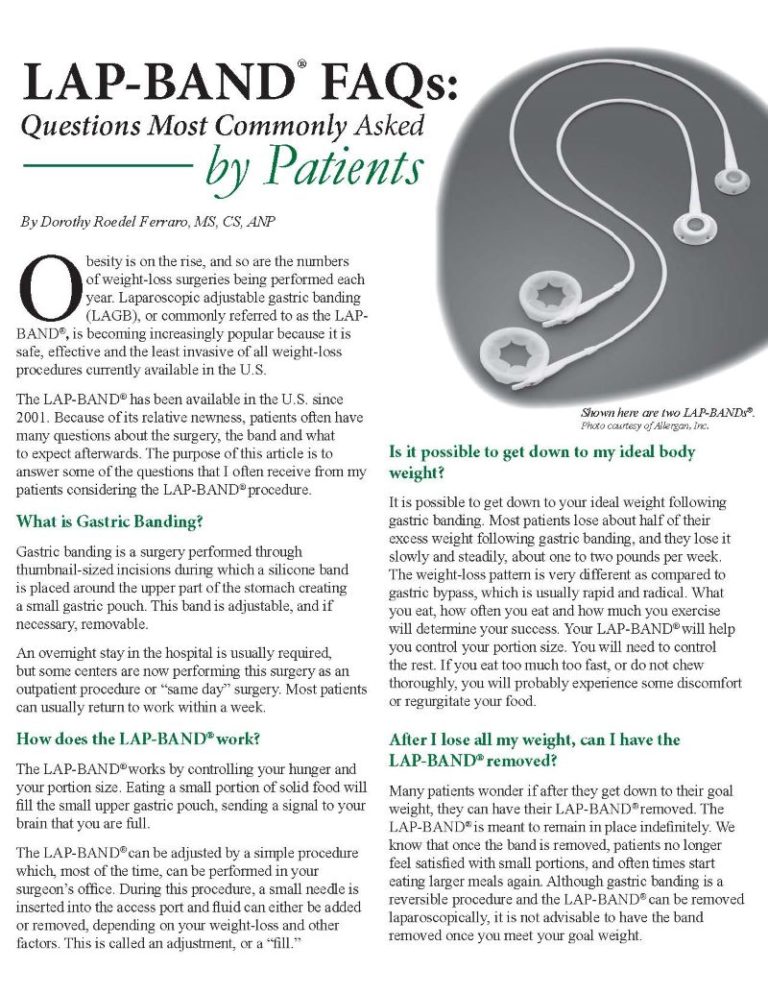
By Dorothy Roedel Ferraro, MS, CS, ANP
Summer 2007
Obesity is on the rise, and so are the numbers of weight-loss surgeries being performed each year. Laparoscopic adjustable gastric banding (LAGB), or commonly referred to as the LAP-BAND®, is becoming increasingly popular because it is safe, effective and the least invasive of all weight-loss procedures currently available in the U.S.
The LAP-BAND® has been available in the U.S. since 2001. Because of its relative newness, patients often have many questions about the surgery, the band and what to expect afterwards. The purpose of this article is to answer some of the questions that I often receive from my patients considering the LAP-BAND® procedure.
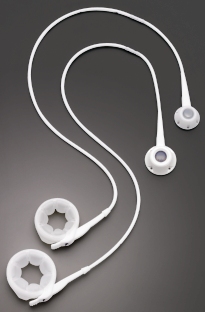
What is Gastric Banding?
Gastric banding is a surgery performed through thumbnail-sized incisions during which a silicone band is placed around the upper part of the stomach creating a small gastric pouch. This band is adjustable, and if necessary, removable.
An overnight stay in the hospital is usually required, but some centers are now performing this surgery as an outpatient procedure or “same day” surgery. Most patients can usually return to work within a week.
How does the LAP-BAND® work?
The LAP-BAND® works by controlling your hunger and your portion size. Eating a small portion of solid food will fill the small upper gastric pouch, sending a signal to your brain that you are full.
The LAP-BAND® can be adjusted by a simple procedure which, most of the time, can be performed in your surgeon’s office. During this procedure, a small needle is inserted into the access port and fluid can either be added or removed, depending on your weight-loss and other factors. This is called an adjustment, or a “fill.”
Is it possible to get down to my ideal body weight?
It is possible to get down to your ideal weight following gastric banding. Most patients lose about half of their excess weight following gastric banding, and they lose it slowly and steadily, about one to two pounds per week. The weight-loss pattern is very different as compared to gastric bypass, which is usually rapid and radical. What you eat, how often you eat and how much you exercise will determine your success. Your LAP-BAND® will help you control your portion size. You will need to control the rest. If you eat too much too fast, or do not chew thoroughly, you will probably experience some discomfort or regurgitate your food.
After I lose all my weight, can I have the LAP-BAND® removed?
Many patients wonder if after they get down to their goal weight, they can have their LAP-BAND® removed. The LAP-BAND® is meant to remain in place indefinitely. We know that once the band is removed, patients no longer feel satisfied with small portions, and often times start eating larger meals again. Although gastric banding is a reversible procedure and the LAP-BAND® can be removed laparoscopically, it is not advisable to have the band removed once you meet your goal weight.
Can I be allergic to the LAP-BAND®?
There have been no case reports of an allergic-type reaction to the LAP-BAND®.
Is it safe to get pregnant with a LAP-BAND®?
It is safe to get pregnant with a LAP-BAND®, but women are usually advised to wait a year or two after surgery before becoming pregnant. Most weight-loss occurs during the first year, so it is usually better to wait until your weight stabilizes before considering a pregnancy. Check with your doctor if you are planning a pregnancy. They will want to make sure you are eating a well-balanced diet, taking your supplements and feeling fit before you become pregnant. And if you do become pregnant, make sure you tell your weight management team. They will want to monitor your nutritional status and weight gain closely.
Will I need to have my LAP-BAND® removed if I become pregnant?
Your LAP-BAND® will not need to be removed if you become pregnant. Your LAP-BAND® will assist you with hunger and portion control during your pregnancy. The notion of “eating for two” often gets women into trouble with too much weight gain. Your band can be adjusted during pregnancy. Some surgeons recommend emptying the band before delivery.
Will I need to take vitamin supplements for the rest of my life?
Because there is no malabsorption with the LAP-BAND®, you will not require the same types of supplements as gastric bypass patients. Usually, taking a daily multivitamin with minerals along with eating a balanced diet is sufficient for most patients. Women may sometimes require a calcium supplement as well.
What about the medications I already take? Will I still be able to take them?
For one month after surgery, any medicine you take will need to be crushed, chewable, in liquid form or smaller than a plain M&M. After the first month, you should be able to take most pills. You may find that as your weight starts to come off and your health starts to improve, you may no longer need all your medications. Many weight-related medical conditions tend to improve or completely resolve with significant weight-loss. Make sure you schedule regular follow-up visits with your healthcare provider, so that he or she can monitor your weight-loss, your medical conditions and your medication needs
Will I feel the LAP-BAND® inside me?
Most patients are only aware of their LAP-BAND® when they eat. You may, however, notice your access port, particularly right after surgery when you are recovering, healing and still feel a little sore.
How many times can the LAP-BAND® be adjusted?
There is no limit to how many times it can be adjusted. Most patients need about three adjustments during the first year after surgery. Your LAP-BAND® can be adjusted as many times as your surgeon finds it necessary.
How will I know if I need an adjustment?
Your surgeon can help you decide if you need an adjustment. If you are hungry, looking for food, and not having optimal weight-loss, you probably need fluid added to your band. If you are experiencing early and prolonged satiety (feeling full after a small portion of food for several hours), and losing one to two pounds per week, your band is working fine, and you do not need an adjustment. If you are having symptoms such as difficulty swallowing, night cough, regurgitation, acid reflux or heartburn, you might need fluid removed.
When your band is optimally adjusted, you should feel satisfied after eating a small portion of food, and you should still be able to tolerate most foods. If you find that you are having difficulty swallowing solid foods, you might not be chewing well enough, you might be eating too fast or your band may be just too tight. Check with your surgeon if you are not sure.
Are adjustments painful?
An adjustment is a quick, simple and relatively painless procedure. It is usually performed in your surgeon’s office. On rare occasions, your doctor will want to do your adjustment using x-ray or fluoroscopy. X-ray is needed if your surgeon cannot feel or find your access port. Fluoroscopy is also helpful if your surgeon suspects you may have a problem.
What is eating like after LAP-BAND® surgery?
Most surgeons require their patients to follow a special diet for the first month after surgery. The diet is progressed from liquids to pureed foods, to soft and then solid foods during the first postoperative month. This gradual progression from liquids to solids allows you to get used to eating with your LAP-BAND®, and allows your stomach to heal.
Eventually, you should be able to tolerate most foods in small portions, provided you chew them thoroughly, eat slowly and avoid foods that are dry, tough or stringy. You will, however, need to change your eating habits. The key to long-term success after LAP-BAND® surgery is making permanent changes in your lifestyle, which include choosing nutritious foods and exercising.
About the Author:
Dory Roedel Ferraro, MS, CS, ANP, has specialized in the field of obesity surgery for more than 13 years and has been instrumental in the development of bariatric practices throughout the United States. She is a graduate of the School of Nursing at Stony Brook where she earned a Master’s degree and certification as a Nurse Practitioner. She is the Clinical Director of Columbia Presbyterian’s Center for Obesity Surgery at Lawrence Hospital and the Medical Director of the Long Island Bariatric Center in Levittown, New York. Dory is also a member of the OAC Advisory Board.
by Robyn Pashby, PhD Winter 2024 “No one is ever going to date you if you don’t…
Read Articleby Kendall Griffey, OAC Communications Coordinator Winter 2024 The Obesity Action Coalition’s 12th annual Your Weight Matters…
Read Articleby Nina Crowley, PhD, RD (with Inspiration from Shawn Cochran) Winter 2024 Dating, no matter your age,…
Read Article




